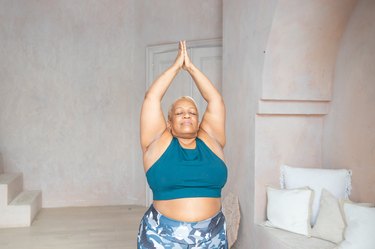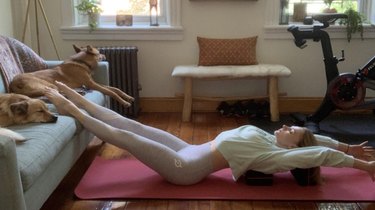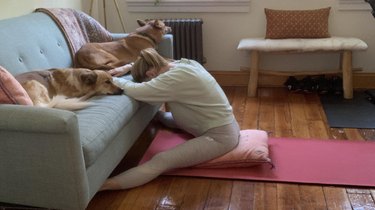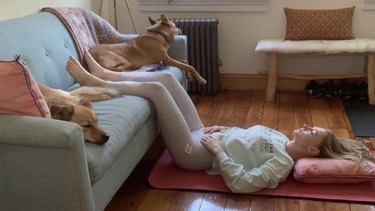
When the going gets tough, the tough roll out a yoga mat. Yep, even a single yoga session can help you better deal with stress, according to a December 2017 study from Complementary Therapies in Medicine.
"When we feel supported and calm, our bodies can actually restore themselves from the inside out and we function better in every aspect of our lives," says Anna Greenberg, Peloton yoga instructor.
Video of the Day
Video of the Day
The following quick restorative yoga sequence from Greenberg not only lets you press pause for 20 minutes while you're on the mat but also reboots your nervous system. Plus, you can do it at home any time you need to recharge.
Tip
Check out more of our 20-minute workouts here — we’ve got something for everyone.
Things You'll Need
Yoga mat
2 yoga blocks
3 pillows or folded blankets
Couch or chair
Tip
No yoga blocks? No problem. Use rolled up blankets, towels, bolsters or pillows instead.
Move 1: Supported Fish

- Lie on your back and place a block on its lowest, widest position beneath your shoulder blades.
- Reach your arms up behind your head and take a big stretch from the tips of your fingers down to your toes.
- Relax your arms by your side.
- Place your legs in one of the following positions, depending on what feels best to you: Elevate your feet on a couch or chair to take pressure off your lower back, leave your legs straight on the floor or bend your knees with your feet on the floor.
- Stay in this posture for 3 minutes.
- To come out, roll to one side off the blocks and set them out of the way for the next pose.
Move 2: Side-Lying Pose Into Gentle Supine Twist

- Lie on your side with a pillow or blanket under your head.
- Stretch your bottom arm out along the floor and rest your top hand on your bottom arm.
- Bend your knees to the same side you are lying on and have them pointing a little bit more up toward your arms than down toward your feet to support the lower back.
- Place a pillow or folded blanket between your knees and your ankles. Hold this pose for 3 minutes.
- Slowly stretch your top arm open to the side, keeping your legs where they are and letting your head turn to center. Stay for 2 minutes.
- Shift to your second side and repeat. You can keep the support under your head and between your knees and ankles.
- To exit, gently make your way up to a seated posture, letting your head be the last thing to lift.
Tip
This shape is basically the fetal position, and it’s very comforting and relaxing. Try breathing into the back of your body in this shape.
The supine twist is a great way to gently mobilize your spine, open up your chest and shoulders and gently stretch out the side body. Only stretch as far as you feel comfortable.
Move 3: Supported Wide-Leg Forward Fold

- Bring your yoga mat up against a chair or couch and sit facing the seat cushion.
- Place a folded blanket or pillow beneath your seat to support your hips. You can have your knees bent or straight, legs wide or narrow — whatever feels best to you.
- Fold forward and rest your forehead on the seat of your couch or chair. If the seat is too low, place your forearms or a folded blanket or two on top of the seat to rest your forehead.
- Let everything relax here, breathe into your back and let your legs be heavy. Stay here for 3 minutes.
- To exit, gently lift yourself up to sitting. Let your head be the last part to lift.
Tip
People tend to be foreword-focused or even “pressed forward” with our thoughts, actions, senses and breath during the day, Greenberg says. Turning inward and supporting the head in this posture is very settling to the nervous system.
Move 4: Modified Savasana

- Snuggle all the way up to the seat of your couch or chair and swing your legs over so your shins rest completely on the seat and your thigh bones drop down into your hips.
- Lay your head down on your pillow or folded blanket and get comfy. Rest your hands on your belly or wherever they feel natural.
- Breathe into your belly, letting every part of yourself relax. Stay here for 4 minutes.
- To exit, gently roll to one side, guiding your legs off of the support and make your way up to sit. Have your head be the last part to lift.
- Take a moment to notice how you feel, and honor the effects of your practice before getting back to your normal routine.
Tip
Savasana, or Corpse pose, allows you to relax and release, making you aware of long-held tension areas in your body and mind and giving you the time to release and restore, Greenberg says. Elevating your legs is a supportive and restorative shape to stay in for Savasana.